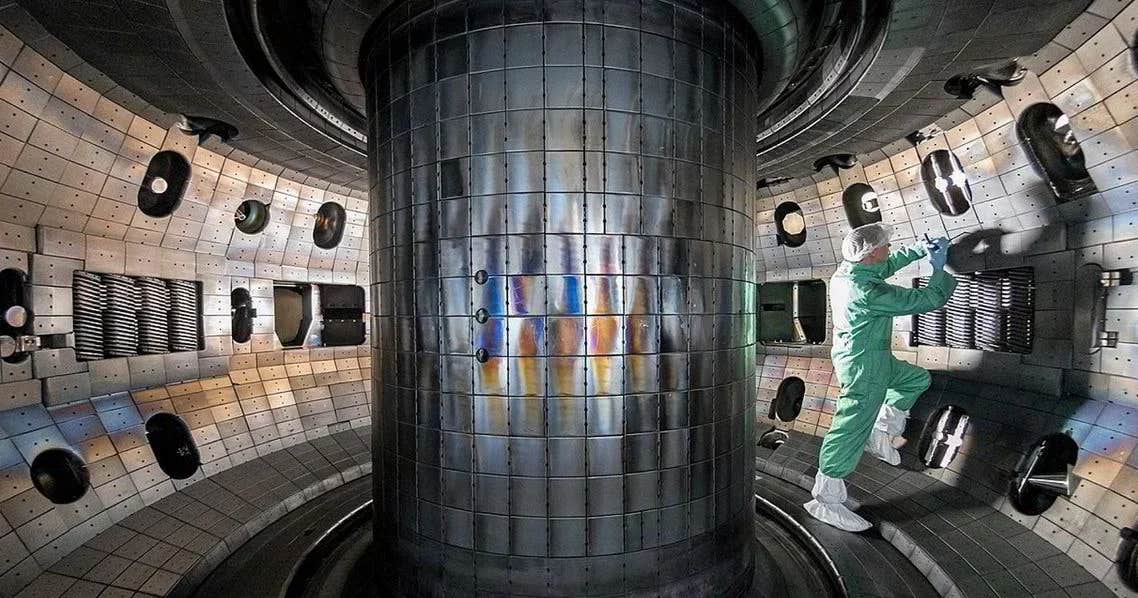Nuclear fusion breakthrough brings us closer to clean limitless power
Nuclear fusion, the process that powers stars, is often hailed as the ultimate sustainable energy solution.

A technician operates within a tokamak at the General Atomics research facility located in San Diego, California. (CREDIT: CC BY-SA 4.0)
Researchers have taken a crucial step forward in the quest for clean, limitless energy. A team at General Atomics, a research facility operated for the U.S. Department of Energy, has reported a significant breakthrough in nuclear fusion.
Published in the journal Nature, their findings mark an important milestone in advancing fusion technology toward commercial viability.
Addressing the Challenges of Fusion Power
Nuclear fusion, the process that powers stars, is often hailed as the ultimate sustainable energy solution. However, replicating this phenomenon on Earth comes with formidable challenges, primarily involving the creation and maintenance of conditions necessary for fusion reactions.
To achieve fusion, scientists must generate and confine plasma—a state of matter consisting of charged particles—at temperatures exceeding hundreds of millions of degrees Celsius. At such extreme conditions, atomic nuclei overcome their natural repulsion, enabling them to fuse and release immense amounts of energy.
Maintaining this high-temperature plasma within a reactor, without it cooling or escaping, is one of the most significant hurdles in realizing practical fusion power.
Tokamak reactors, which are doughnut-shaped devices that use magnetic fields to confine plasma, are a leading technology in nuclear fusion research. A major challenge with tokamak reactors, however, has been managing the density of the plasma, which is limited by what is known as the Greenwald limit.
Understanding the Greenwald Limit
The Greenwald limit, named after physicist Martin Greenwald, defines the maximum density that a plasma can reach while remaining stable within the magnetic confinement system of a tokamak reactor. If plasma density exceeds this threshold, instabilities can arise, disrupting the confinement process and halting fusion. Essentially, the Greenwald limit is a barrier to achieving the conditions necessary for efficient and stable fusion power.
Related Stories
In tokamak reactors, this limit has been a persistent obstacle because, beyond a certain density, the plasma becomes unstable, leading to energy loss or potential damage to the reactor. The inability to exceed the Greenwald limit without significant consequences has posed a challenge for creating a fusion reactor that could operate efficiently and continuously.
Breaking Through the Limit
The General Atomics research team has now managed to overcome this barrier. Their experiment produced stable plasma with a density that is 20% higher than the Greenwald limit. Not only did they achieve this higher density, but they also maintained a plasma confinement quality that was 50% better than the standard high-confinement mode typically used in tokamak reactors.
This breakthrough is significant because it addresses a major bottleneck for commercial fusion reactors. Many tokamak designs require plasma densities higher than the Greenwald limit to achieve efficient fusion.
Previous attempts to exceed this limit often resulted in reduced plasma confinement or complete loss of energy. The success of the General Atomics team in achieving both high density and strong confinement opens up new possibilities for designing more efficient and reliable fusion reactors.
Managing Plasma Instabilities
Another major hurdle in fusion reactors like tokamaks is controlling the instabilities that can develop within the plasma. These instabilities, if left unchecked, can disrupt the reactor's operations and damage its components. The recent findings from General Atomics not only surpassed the Greenwald limit but also hinted at potential methods for managing these instabilities.
The researchers noted a "synergy" between achieving high plasma density and maintaining high confinement, which could lead to a more stable state for the plasma. This suggests that it may be possible to achieve conditions where the plasma remains stable even at higher densities, reducing the risk of disruptions that have previously been a major challenge.
Balancing Temperatures in the Plasma
Fusion reactors also face the challenge of balancing temperatures within the plasma. To initiate fusion, the core of the plasma must be extremely hot—reaching hundreds of millions of degrees Celsius—while the outer edge, which comes into contact with the reactor walls, needs to be kept much cooler to prevent damage. Achieving and maintaining this balance is crucial for the reactor's efficiency and longevity.
The research from General Atomics provides new insights into how to manage this temperature gradient effectively. Understanding the physics that govern the temperature distribution within the plasma can help in designing reactors that are both compact and efficient. These insights bring researchers closer to solving one of the critical engineering challenges that have held back the development of practical fusion power.
The breakthrough by the General Atomics team represents a significant step towards achieving commercially viable fusion power. By breaking through the Greenwald limit and demonstrating improved plasma confinement, they have unlocked new opportunities for more efficient fusion energy production.
This development could pave the way for the creation of fusion reactors that are capable of operating under conditions necessary for sustained and efficient power generation.
While there is still much work to be done before fusion power becomes a reality, the progress made by these researchers is a clear indication that we are moving in the right direction.
Achieving stable, high-density plasma in a controlled environment is one of the key milestones on the path to fusion energy, and the recent advances are an encouraging sign that the dream of clean, limitless energy may one day become a reality.
Key Takeaways
- Nuclear fusion is a promising source of clean and sustainable energy, but creating and maintaining the conditions for fusion is extremely challenging.
- Tokamak reactors use magnetic fields to confine the hot plasma needed for fusion, but plasma density is limited by the Greenwald limit, beyond which instabilities disrupt confinement.
- Researchers at General Atomics have successfully surpassed the Greenwald limit, achieving plasma density 20% higher while maintaining superior confinement.
- This breakthrough addresses a major obstacle for fusion reactors, making it possible to achieve conditions required for efficient fusion.
- The research also provides insights into managing plasma instabilities and balancing core and edge temperatures, critical for reactor efficiency.
- These advancements mark a significant step towards the realization of commercially viable fusion power.
Note: Materials provided above by The Brighter Side of News. Content may be edited for style and length.
Like these kind of feel good stories? Get The Brighter Side of News' newsletter.
Joseph Shavit
Head Science News Writer | Communicating Innovation & Discovery
Based in Los Angeles, Joseph Shavit is an accomplished science journalist, head science news writer and co-founder at The Brighter Side of News, where he translates cutting-edge discoveries into compelling stories for a broad audience. With a strong background spanning science, business, product management, media leadership, and entrepreneurship, Joseph brings a unique perspective to science communication. His expertise allows him to uncover the intersection of technological advancements and market potential, shedding light on how groundbreaking research evolves into transformative products and industries.



